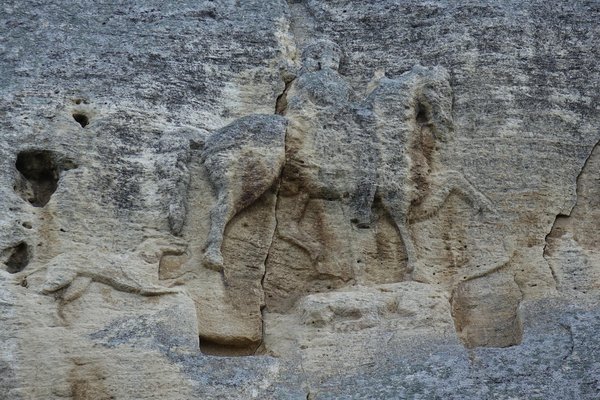Bulgaria
Madara Rider
The Madara Rider is a large rock relief that is a highlight of pagan Bulgarian art.
The relief depicts a scene revolving around a majestic horseman 23m above ground level in an almost vertical 100-metre-high cliff. The scene is surrounded by inscriptions that are a chronicle of events. The 8th-century monument is usually attributed to the Khans of the First Bulgarian Empire.
Community Perspective: The relief is chiseled high up the cliff wall – with the naked eye you can see the Rider but not the inscriptions. The core zone is very limited and you will be done with it in 15 minutes, but the surrounding area is worth exploring (see Tsunami’s review).
Site Info
Official Information
- Full Name
- Madara Rider (ID: 43)
- Country
- Bulgaria
- Status
-
Inscribed 1979
Site history
History of Madara Rider
- 1979: Deferred
- As "Horseman of Madara": Bureau - ICOMOS wants comparative info
- 1979: Inscribed
- Inscribed
- Type
- Cultural
- Criteria
- i
- iii
Links
- UNESCO
- whc.unesco.org
- Official
-
- bulgariatravel.org — The Madara national historical-archeological reserve
All Links
UNESCO.org
- whc.unesco.org — whc.unesco.org/
Official Website
- bulgariatravel.org — The Madara national historical-archeological reserve
Community Information
- Community Category
- Archaeological site: Rock Art
Travel Information
Recent Connections
-
On Euro coins
Bulgarian Euro coins (from 2026): "The … -
Need for a Comparative Study
Bureau 1979 -
Bulgarian Empire
The cultural heritage of the First Bulg…
Connections of Madara Rider
- Trivia
-
-
On Euro coins
Bulgarian Euro coins (from 2026): "The designs feature the Madara Horseman on the obverse of the 1, 2, 5, 10, 20, and 50 cent coins"See www.bta.bg
-
On Euro coins
If and when Bulgaria ever joins the Euro this has been chosen already for depiction on the Bulgarian Euro coinSee www.novinite.com
-
- History
-
-
Bulgarian Empire
The cultural heritage of the First Bulgarian Empire is usually defined in Bulgarian historiography as the Pliska-Preslav culture, named after the first two capitals, Pliska and Preslav, where most of the surviving monuments are concentrated. The Madara Rider is one of them.
-
- Architecture
-
-
Stand-alone Rock Reliefs
OUV: "The Madara Rider is a unique relief, an exceptional work of art,... It is the only relief of its kind, having no parallel in Europe. It has survived in its authentic state. It is outstanding not only as a work of Bulgarian sculpture, with its characteristically realist tendencies, but also as a piece of historical source material dating from the earliest years of the establishment of the Bulgarian state. The inscriptions around the relief are, in fact, a chronicle of important events concerning the reigns of very famous Khans."
-
- World Heritage Process
-
-
Single Monuments
Also meets criterion i: masterpiece of human creative genius. -
Need for a Comparative Study
Bureau 1979
-
- Constructions
-
-
Equestrian Statues
Early mediaeval relief (c710 AD) of a mounted warrior killing a lion. It possibly represents a Khan of the nomadic Bulgars who had recently arrived in the area. It and the related inscriptions provide important clues to this period of Bulgarian history
-
- WHS on Other Lists
-
-
World Monuments Watch (past)
(1998, 1996)
-
- Timeline
-
-
Built in the 8th century
Dated to 710
-
- WHS Hotspots
News
No news.
Recent Visitors
Visitors of Madara Rider
- Adrian Turtschi
- alex
- Alexander Barabanov
- Alexander Lehmann
- A. Mehmet Haksever
- Anna Wludarska
- Argo
- Ask Gudmundsen
- Astraftis
- Atila Ege
- BaziFettehenne
- Bill Maurmann
- Bin
- Brendan Carroll
- Carlos Sotelo
- Cezar Grozavu
- chenqtao
- Cluckily
- Clyde
- Corinne Vail
- Csaba Nováczky
- CynthiaW
- Dagmara
- Dan Pettigrew
- DavidS
- Dimitar Krastev
- Dreamcatcher
- Elia Vettorato
- Elis
- Els Slots
- Emili Xaus
- Erik Jelinek
- Eva Kisgyorgy
- Fan Yibo
- Feldhase
- Filip Murlak
- FS
- George Gdanski
- GeorgeIng61
- GerhardM
- Hadrianus
- Harald T.
- Harry Mitsidis
- H Beswick
- Hubert
- Iain Jackson
- Igloo
- Ivan Rucek
- Janos
- Jarek Pokrzywnicki
- Jasam
- Joel on the Road
- John Smaranda
- Jonas Kremer
- jonathanfr
- Joyce van Soest
- Justin Rickey
- KentishTownRocks
- Knut
- Lisu Marian
- Luboang
- Ludvan
- Luis Filipe Gaspar
- Maciej Gil
- Małgosia Łupicka
- Martina Rúčková
- Mathijs
- Mihai Dascalu
- Mikko
- Milan Jirasek
- Miloš Tašković
- Mtlmr
- nan
- Nihal Ege
- opperpco3
- Patrik
- petar
- Peter Lööv
- Petteri
- Philipp Leu
- Philipp Peterer
- Piotr Wasil
- Rafał Kałczuga
- Randi Thomsen
- Roger Ourset
- Roman Bruehwiler
- Roman Raab
- Sabrina Liebehentschel
- Schnitzel
- Sebasfhb
- Shandos Cleaver
- Slavi
- Solivagant
- Stan
- Stanislaw Warwas
- StaziG
- Stijn
- Svein Elias
- Szucs Tamas
- Tamara Ratz
- Taotao Chen
- Tarquinio_Superbo
- Thomas Buechler
- Thomas van der Walt
- triath
- Tsunami
- UncleSlavi
- Valentina
- Viaje al Patrimonio
- Vsacan
- Wojciech Fedoruk
- YaroMir
- Zoë Sheng
Community Reviews
Show full reviews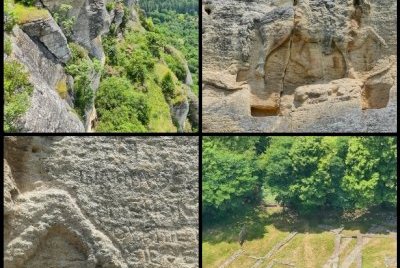
I visited this WHS in 2023 as part of the northeastern Bulgaria hotspot. Of the inscribed lot in this hotspot, the Srebarna Nature Reserve seems to be rated as the worst, probably owing to its poor state of upkeep of any trails or tourist infrastructure but also because to the non-birder (and not only) it pales when compared to the Danube Delta nearby.
To me, however, Madara Rider ranked the lowest. It is an interesting site to visit while visiting Bulgaria, but its only highlight, the Madara rider relief, in my opinion lacks OUV and is more of an interesting niche national site. It isn't unique either as similar carbon images have been found in Saltovo, Soulek, Pliska and Veliki Preslav.
The horseman relief, almost life-size, is carved on a 100 metre vertical cliff. The Madara rider is facing right, and can be seen thrusting a spear into a lion lying at his horse's feet, while on the left a dog is running after the horseman. The carving of the rider's halo and garments, as well as the bird in front of the horseman's face, are barely recognizable due to centuries of erosion and the generally poor condition of the monument. This is even more noticeable if you try to approach/climb to the locked metal gate of the ugly green metal-frame platform just beneath it.
The meaning and symbolism of the sculpture are uncertain, as well as its actual masonry tradition and cultural source. The relief probably …
Keep reading 0 comments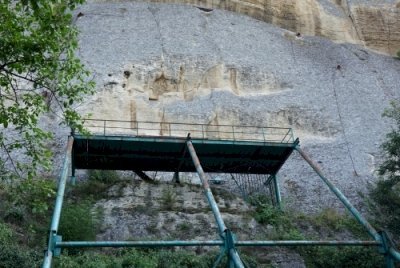
The Madara Rider is the symbol of the Bulgarian nation. An image of it can be found on the back of most of its coins for example. The relief carved into a cliff at an elevation of 23m is seen as the climax of pagan Bulgarian art. It shows a rider on a horse, attacking a lion with his spear. A dog walks behind the rider. Next to it are 3 inscriptions in Greek that refer to the Bulgarian rulers of the 8th and 9th centuries.
Madara lies an hour away from the Black Sea coast in Varna, where we started this day. "We" is the WH Travellers community, gathered for its annual meeting: 15 people from 10 countries and 3 continents. We travel for two days with rental cars through north-eastern Bulgaria, with the aim of visiting 4 World Heritage sites plus a few tentative sites.
After a pleasant start to the day in nearby Pobiti TWHS, we were in Madara before 10.30 am. Given the status of the site, one would expect a spacious terrain and buses with tourists. But it does not even have a parking lot: just dump your car by the side of the road. There are a few souvenir shops however and – after worrying beforehand and bringing our own snacks for lunch - we counted 3 restaurants to serve lunch.
To get to the relief with the rider, you have to tackle a stone staircase with more than 200 steps. …
Keep reading 0 comments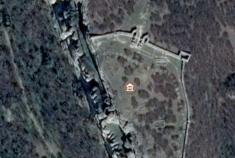
Staying in Shumen overnight, I spent several hours in Madara in the afternoon. Took a bus to Madara and a train back to Shumen. From the bus / train station it's uphill walk for 1.5 km to the base of the National Historic and Archaeological Reserve, which includes the relief of the Madara Rider on the rock...cliff of a table mountain / plateau.
I think Madara Rider is my favorite WHS in Bulgaria, not just because of the relief, which is the core zone in itself, but of the whole reserve, which is basically the buffer zone. The reserve includes even some Neolithic and Thracian settlements, some Roman ruins (close to the train station), a 4th century fortress on top of the table mountain, and the remains from the middle age, which includes a monastery with cells for monks hewn into the cliff. In other words the reserve is a human history in a nut shell.
There is also a one-room museum, which was closed, but by asking around when it's open, someone managed to bring another person who opened the door for me for a few minutes. The room contained relevant artifacts from the archeological area.
I spent the hours walking around and up and down. The dramatic mountain setting even reminded me of Masada in Israel.
The photo shows the locations of the Madara Rider relief on the cliff, the fortress on the table mountain top and the screen capturer on the edge of …
Keep reading 0 comments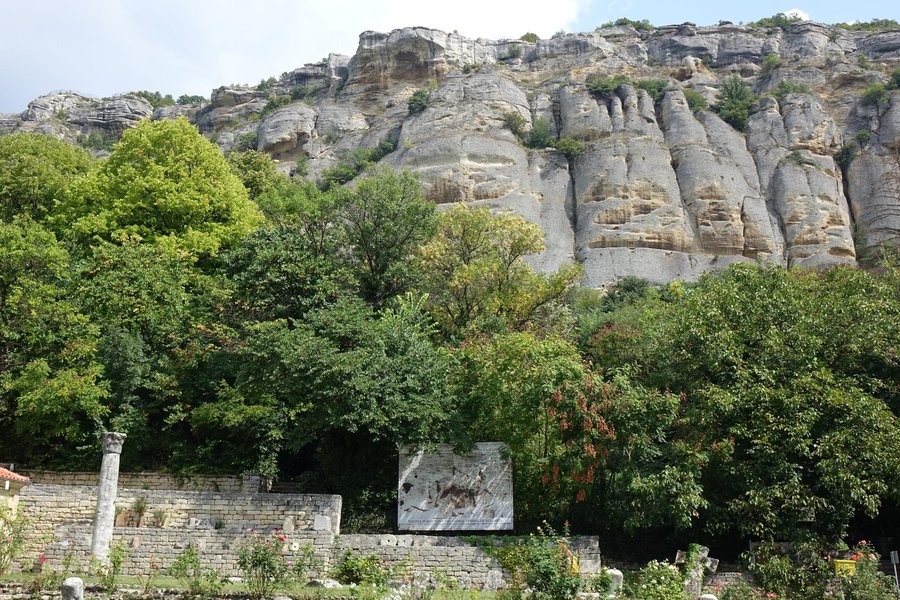
I’m from Bulgaria and my name is Stoil Stoilov.
I have been many times in the village of Madara visiting the historical Madara Horseman site. I have spent 10 years in research in the ancient Bulgarian history and found out many new facts and made some important conclusion about the ancient Bulgarian history and among hen about the origin and meaning of the Madara monument which I represented in a book.
The book “They called themselves Bulgarians”, ISBN 978-954-9447-83-5 of the author Stoil Traykov Stoilov sets out and proofs a number of new ideas about the origin of the Bulgarian people and the ancient Bulgarian history: • The Bulgarians are from indoaryan, saka (scythian), toharian and from some other peoples/tribes origin; • The main kings tribe was the Onogonduri tribe. It was composed from the population of an ancient highly developed country Gandhara > Gondur of nowadays Pakistan and the Chionite tribe (Oiono, Ounnoi). After heavy battles in 515 AD with the White huns of Toramana and his son Mihirakula they were forced to emigrate to the west in a total number of 800000 men and women. They were followed by the population of many other regions of nowadays Afghanistan, Pakistan and Northern India. • In 632 the Great Bulgaria was found; • In 680/681 kan Asparuh with the Onogondurs moved to the south of Danube to create the Danube Bulgaria. • It can be supposed that in 715 AD the very successful Bulgarian king Tervel ordered in memory of …
Keep reading 0 comments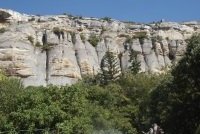
The image of the Madara Rider is clearly important to Bulgaria; it is reproduced on all of its stotinki coins. Certainly the site appears to be revered by Bulgarians, who flock to see the engraving.
What is amazing is the location of the carving. How did the artists reach the site so high above the ground 1400 years ago?
I reached the site by train from Shumen to Madara village. The site is quite a hike uphill from there, followed by a long flight of stairs.
Keep reading 0 comments
I have visited the Madara site one week ago.
The horseman in itself is not such a wonder as you can imagine, but you can really percieve the flowing of millennia looking at it. The site is very quiet as all the Madara village and the sorroundings. You can walk to the rest of the site (caves, etc.) through paths in the vegetation. Many benches to sit all around and where meditate on history.
The Madara site is not far from the Madara railway station, you can easily walk there in 20-30 minutes.
Keep reading 0 comments
